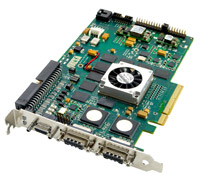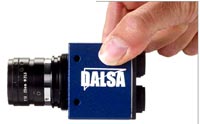 BOA ADVANCED SMART COLOUR CAMERA: Excellence in a small package
BOA ADVANCED SMART COLOUR CAMERA: Excellence in a small package
Comprising all the elements of an extremely capable industrial machine vision system in a tiny, smart camera package
Following their successful introduction of the BOA monochrome smart camera, DALSA now announces the availability of colour processing through the release of the highly- integrated BOA smart colour camera.
 Supported with a full suite of vision tools, the new colour version of the BOA sets a new cost/performance standard for colour enhanced smart camera solutions.
Supported with a full suite of vision tools, the new colour version of the BOA sets a new cost/performance standard for colour enhanced smart camera solutions.
When and why should colour be used in machine vision?
While colour inspection is often a requirement in the automotive, food packaging and pharmaceutical industries, it should be used any time there is a need to evaluate the presence or density of a colour, its evenness of distribution, or its similarity to some known reference.
In the field of food production, for example, it might mean allowing the producer to ascertain ripeness and grade product quality or to distinguish foreign matter in a steady stream of product. In meat processing, colour can be used to detect spoilage and discriminate areas of fat, bone and gristle for automatic trimming. Also, there is a large variety of quality and grading applications that involve colour and texture classification. Products like wood, textiles and ceramic tile are just some examples.
There are some applications where the use of colour is obvious and almost mandated but where there is uncertainty, how do you discern and then decide if colour vision benefits your process? |
|||
If you can answer "yes" to any of the following questions, then colour vision should be a serious consideration for your application. |
|||
| • Is the object’s colour quality and consistency a key factor in the overall quality of your product? • Can the object’s colour help you to ascertain the relative quality of you product? • Will colour facilitate detection of the object? |
 |
||
| How will the BOA Colour Smart Camera enhance your operations? | |||
BOA is a highly integrated optical inspection tool for controlling quality and increasing productivity. It comprises all the elements of an industrial machine vision system in a tiny smart camera style package: Specially designed for industry, the ultra-small BOA's 44 x 44 x 39 form factor is perfect for tight-fit set-up and the IP67-rated housing means that the camera can be directly deployed in harsh, wash-down environments. This is particularly useful to meet control standards in the food and pharmaceutical industries, and eliminates the need for a separate, costly protective enclosure. |
|||
Colour is used to ascertain ripeness and to |
|||
| How smart is "smart?" Key features of the BOA Smart Colour Camera | grade product quality in fruit and vegetables |
||
| • Fully integrated smart vision system | • Mono and Color CCD sensor options | • Ultra small form factor 44 x 44 x 44 mm | |
| • Industrial IP67 Housing | • Easy application setup via Laptop or PC | • M4 mounting holes on each surface | • Connects to standard vision lights |
| • Utilizes factory M12 style cord sets | • No software to install | • Low power consumption (3 watts) - Runs Cool | • Suitable for both novice users and experts |
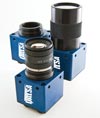 |
 |
 |
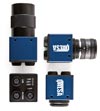 |
How can I use the BOA Smart Colour Camera?
The BOA colour smart camera can be applied to a broad range of colour inspection applications such as:
• identification of parts or assembly features
• sorting, counting, and verification of colour hue.
• print inspection (quality/registration)
• pharmaceutical inspection (label verification)
• PCB assembly (part presence, verification and placement)
• positioning robotic handlers
Easy to use
The colour tools can be easily combined with standard measurement or identification tools to perform a complete inspection of the part or assembly. The easy-to-use, iNspect Express software interface, allows users to rapidly prototype and deploy solutions, and it is available with a fully-featured emulator for offline application development and debugging.
Quick Specs |
|
| Resolution | 640 x 480 (higher resolutions are coming) |
| Sensor | 1/3" colour CCD |
| Max frame rate | 60 frames-per-second |
| Processing | Real-time Embedded Processing. Multiple processing engines DSP CPU FPGA, 256 MB Memory |
| Integration | Opto-iso I/O, 10/100 BaseT Ethernet w industiral protocols, Passive Power over Ethernet, RS-232 link, Integrated lamp connector. Exposed status LEDs |
| Lens mounts | Supports a standard C mount lens with an optional protective cover |
Delivering great performance at a very reasonable price, the BOA Smart Colour Camera is a truly exceptional, all-in-one intelligent vision system
Xcelera HS PX8: defining the NEXT-GENERATION of frame grabbers
Bringing new levels of performance and flexibility to machine vision applications
Recognising the emerging needs of bandwidth-hungry machine vision applications, DALSA has called on its field-proven design and manufacturing expertise to develop the Xcelera HS PX8, bringing traditional image-acquisition and processing technology to new levels of performance and flexibility.
Designed with the future requirements of the machine vision OEMs in mind, DALSA's Xcelera HS Series is shaping next-generation frame grabber capabilities to deliver image acquisition bandwidth of 1.8GByte/sec and host transfer bandwidth of 2GByte/s over multiple-lane PCI Express implementations, and with room to grow.
What features can I expect from the Xcelera HS PX8? |
|
|
** HS-Link Interface - Next generation image-acquisition interface. (Click here to learn about HS-Link) |
** Image acquisition at rates up to 1.5GByte/s |
|
** Ultra compact, field proven CX4 cable and connector |
|
** PCIe host interface (Click here to learn about PCIe host interface) |
|
** The combining of an HS-Link interface with onboard preprocessing functions such as shading correction, Bayer decoding etc |
|
** Image-acquisition bandwidth of 1.8GByte/sec and host transfer bandwidth of 2GByte/s over multiple-lane PCI Express |
|
** Trigger-to-Image Reliability technology framework (Click here to learn about Trigger-to-Image technology) |
|
** Built-in support for data forwarding for distributed processing |
|
| ** Dedicated communication channel supporting data rates up to 300MByte/s (600MByte/s total) | |
What software supports the Xcelera HS PX8?
The Xcelera HS PX8 frame grabber is supported by DALSA’s Sapera Essential software package, a cost-effective machine vision software toolkit that bundles board level acquisition and control with advanced image processing capability and now featuring a value-added, all-new geometric search tool.
How do I benefit from using this software?
Sapera Essential is designed to deliver the critical functionality needed to design, develop and deploy high-performance machine vision applications while at the same time significantly lowering deployment costs.
Quick Specs |
|
| Resolution | Horizontal size: 8 bytes to 256 Kbytes. Vertical size: 1 line to infinite for line scan, 1 line to 16 million lines in area scan. Support variable frame length (up to 16 million lines) |
| On-Board Memory | 256MB |
| Card Acquisition | Half-length PCIe card, compliant with PCIe Rev. 1.1. 1 x camera based on CX4 cable technology. Area scan and line scan. Data rate up to 1.5 GB/sec |
| Scanning | Progressive |
| Pixel Format | Support for 8-bit. Future options: 10, 12, 14 and 16-bit mono, 24-bit RGB and Bayer |
| Max. data rate | Front End BW: 1.5 GB/sec. Back End BW: 1.5 GB/sec |
What is...?
HS-Link Interface
The HSLink1 interface is a new machine vision connectivity interface pioneered by DALSA. HSLink is designed specifically to meet the needs of all machine vision applications and therefore carries image data, configuration data and low jitter, real time triggering signals over a simple network topology supporting cameras, intermediate devices and frame grabbers. The interface has taken the key strengths of Camera Link, and added new features and functions. HSLink delivers scalable bandwidth of 300 to 6000 Mbytes/s, 1x to 20x configurations while using globally available, off-theshelf components.
PCIe host interface
PCIe host interface is a point-to-point host interface and allows simultaneous image acquisition and transfer involving little intervention from the host CPU
Trigger-to-Image Reliability technology framework
Trigger-to-Image Reliability technology framework leverages DALSA’s hardware and software innovations to control, monitor and correct the image acquisition process from the time that an external trigger event occurs to the moment the data is sent to the host providing traceability when errors do occur and permitting recovery from those errors.
 Unified Software For a Unified Product Range: AVT's Universal Package SDK
Unified Software For a Unified Product Range: AVT's Universal Package SDK
Optimising performance for AVT cameras:
A single Software Development Kit for Windows
Announcing the FREE SDK from AVT: their Universal Package v1.0
What is AVT's Universal Package?
The AVT Universal Package is a comprehensive software development kit (SDK) designed for 32-bit Windows operating systems that can be used with both FireWire (IEEE1394a/b) and GigE Vision® compliant cameras from AVT. The focus of this kit is to enable the development of high performance applications and simplified control of AVT cameras' Smart Features.
The AVT Universal Package relies on components of the AVT FirePackage and the Prosilica PvAPI SDK for FireWire and GigE cameras respectively and so making the new SDK compatible with AVT's entire camera portfolio.
The software package includes high-performance FireWire and GigE drivers with minimal CPU load, along with the appropriate installation tools and a viewer application to test and configure AVT cameras.
Why is AVT's Universal Package a useful addition to my application?
AVT's Universal Package:
• transfers data reliably with high bandwidth and at a very low CPU load
• provides a Universal API for camera interface-independent camera control
• simplifies camera Smart Features access
• is useable within the most popular software development environments
• enables multi-camera viewer application with video recording function
• allows for easy integration of AVT cameras into a Windows-based application through a comprehensive example collection and documentation
With AVT's Universal Package, system developers can get the best out of their AVT cameras' smart features, whether FireWire or a GigE Vision |
What can I do with the Universal Package SDK?
In combination with AVT cameras' powerful Smart Features, the Universal Package enables programmers to develop high-performance machine vision applications that require time-critical and asynchronous imaging, sometimes with rapidly changing data rates in single or multiple camera operation.
What is included in the package? |
| Free of charge and downloadable from the link below, the kit provides the following components: |
| • High-performance OHCI compliant IEEE1394 bus driver supporting data rates up to 800 Mbit/s |
| • 1394 bus driver install tool inclusive silent driver install capabilities |
| • NDIS GigE filter driver reducing the CPU load significantly |
| • Universal application programming interfaces applicable for all AVT cameras provided as a C dynamic link library (DLL) and .Net assembly, |
| • Useable with Microsoft’s Visual Studio or other development environments like Borland C++ |
| • Viewer application (AVT UniCam) to evaluate some Smart Features, or just to test and configure the camera itself, inclusive IP configuration for AVT GigE Vision® cameras |
| • Various examples based on the UniAPI (Universal Application Programming Interfaces) |
| Included with the package are: • User Guide as PDF, providing a general overview about the SDK and its installation • Programmer’s reference manual as HTML online help (CHM file) describing the UniAPI and its usage |
CLICK TO DOWNLOAD Allied Vision Technology's Universal Package v1.0
 High Speed focus on the Film and TV industry with Vision Research
High Speed focus on the Film and TV industry with Vision Research
ADEPT showcases new high-speed camera and accessories from Vision Research to the Australian cine industry
Directing their focus on the film and TV industry, Adept were pleased this month to showcase the new high-speed cameras and accessories to the Australian Cinematographers Society
BRISBANE SYDNEY MELBOURNE
With a combined attendance of over 100 of Australia's leading cinematography and broacast directors and technicians, the Australian Cinematographers Society hosted Adept Electronic Solutions who presented the new Phantom v640 super slo-mo digital camera and Remote Control Unit.
Invited by Adept to Australia for these events, Phiroze Dalal Vision Research's European application specialist put their new products through their paces with live demonstrations in a personal and interactive environment. Vision Research are long-recognised for their advanced standing in the film and TV industry with the Phantom HD and the more recent HD Gold. Now the v640 stands to break new ground in this demanding and exciting industry.
| What was in the showcase? Chosen for presentation were a selection of new Vision Research products *** Phantom high-speed v640 camera and latest-release software *** Phantom Remote Control Unit *** Phantom CineMag storage unit *** Phantom CineStation |
|||
About Vision Research |
|||
|
Prominent in the marketplace with an impressive series of "firsts" and an award-winning history of innovative technology and unique products, Vision Research provides what directors need; consistency and reliability with high speed, high resolution and unsurpassed image quality. Vision Research remains as the technological leader with the release of these new products and the company prides itself on its aggressive R&D plans for the future. |
||
| What we saw | |||
Adept's presentation focused on the Phantom v640 and demonstrated its successful and efficient cine capture at full resolution and high speed 1500 fps. A key feature of the v640 which was noticed and applauded by the broadcast attendees is the v640's Dual Flexible HD-SDI output . This allows for simultaneous recording and playback. Ideal for super slo-mo sports applications where the next high speed event can be captured while the previous event is being played back and broadcast. Also demonstrated was the new Remote Control Unit with wireless option and touchscreen for full camera control. This product allows DOP's full mobility and flexibility on set. |
|||
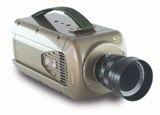 |
Phantom v640: The camera of choice for digital high-speed video |
||
Phantom Remote Control Unit |
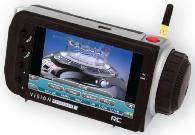 |
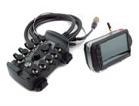 |
|
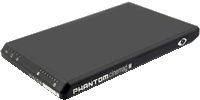 |
Phantom CineMag: High-speed imaging is memory hungry: CineMag is the solution |
||
Phantom CineStation: an offline docking station Features *** snap CineMag to the CineStation to view or download *** simple setup that connects directly to a PC *** aids workflow: allows CineMags to be viewed, trimmed, recorded, and saved to hard disk *** connects to PC and leaves the camera free to shoot *** plays the cine files stored on the CineMag over dual HD-SDI video outputs or component video *** faster download possible with optional 10GB Ethernet connection Read more about the Phantom CineStation |
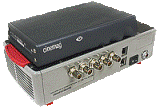 |
||
| Latest release software Phantom Camera Software version 275.2 Version 675.2 is the latest general release of the Phantom camera control software. This version includes support for many cameras in the Phantom range. It includes many enhancements and support for new features like the internal and external mechanical shutters and is a recommended upgrade for most Phantom users. Phantom Camera Software version 278 Version 678 is the latest interim release of the Phantom camera control software. This version is for use with the Phantom HD / HD GOLD camera |
|||
 DALSA pioneers new machine-vision connectivity interface
DALSA pioneers new machine-vision connectivity interface
Pioneered and encouraged by DALSA: the HSLink interface
DALSA continues their pioneering endeavours by being instrumental in the development of HSLink, a new machine-vision connectivity interface.
Working together with the Camera Link2 subcommittee, the intention being to present reference designs and a more complete specification for industry's use as the next-generation machine-vision interface.
What is HSLink?
HSLink is designed specifically to meet the needs of all machine vision applications and therefore carries image data, configuration data and low-jitter, real-time triggering signals over a simple network topology-supporting cameras, intermediate devices and frame grabbers required by end customers
Why is HSLink an improvement on the previous standard??
The interface has taken the key strengths of Camera Link™ (an industry-specific connectivity solution), while using broadly-used, off-the-shelf components with development road maps for increased performance. This protocol will have a long service life and is designed to ensure longevity in the marketplace with an expected life cycle 10 - 20 years.
As well, new features and functions have been added to meet customers' present and future needs.
HSLink is designed from a system point of view, ensuring the ability to create low cost cameras and frame grabbers, while meeting the ease of use, flexibility and data reliability required by end customers. |
In brief, what are the some of HSLink's features and benefits? |
|
| Globally available | • Off-the-shelf components are used. No license or royalty fees. No chip-supply issues. |
| Scaleable bandwidth | • Scaleable in 300MB/s steps from 300 to 6000 Mbytes/sec, 1x to 20x configurations, while maintaining a common, consistent control interface and ease of implementation. |
| Camera size | • Minimised |
| Triggering | • Protocol handles real-time triggering. No need for a separate trigger cable. • Real-time triggering - low jitter of 3.2ns makes HSLink viable for linescan applications |
| Data transmission | • Reliably achieved through redundant trigger codes, hardware resend capabilty (this enables minimal buffer sizes and so no external memory is required), and proven technology. |
| Plug and Play | • Cameras are GenICam™ |
| Video efficiency | • HSLink Protocol - exceeding 95% video efficiency. |
| Lower cabling costs | • Having scaleable bandwidth capacity also lowers cabling costs and size as the cable can be selected according to the camera's bandwidth |
|
|||||||||
| The HSLink IP Core takes in Camera Link signals and priority manages trigger, GPIO image data and configuration data and sends this information to the PHY via GMII (Gigabit Media Independent Interface) and/or NBI (Nine Bit Interface). The HSLink IP core ensures guaranteed data delivery and simplifies design implementation in both framegrabbers and cameras. Multi-vendor PHYs, that operate on NBI and GMII, are available that serialize and de-serialize the data transmitted over the cable medium. For low bandwidth applications (<300Mbytes/s), Infiniband (IBx1) or Coax cabling offers a low cost solution. For applications up to 2100Mbytes/s, a single CX4 cable is used, which significantly reduces the size and number of cables required compared to today’s machine vision standards, and still delivers 15m transmission distances. |
|||||||||
|
|||||||||
As seen in both diagrams, the HSLink IP Core takes in input signals that the machine vision industry understands from the CameraLink standard. |
|||||||||
Read about HSLink |
Access the article to learn about: | |
| • Cabling | • Transmission distance | • The chip |
| • 8b/10b encoding | • Kcodes and Message Types | • HSLink IP Core |
| • Priority Technology | • Data and Trigger Reliability | • CRC Calculation |
| • HSLink – Protocol | • NBI (- Bit Interface) Protocol | • GMII Protocol |
| • Packet design/functionality | • Idle Set | • System Configurations |
| • Data Forwarding | • Intermediary Devices | • HSLink comparison |
Adept Electronic Solutions are "The Machine Vision and Imaging Specialists" and distributor of Stemmer products in Australia and New Zealand. To find out more about any Stemmer machine vision products, please email us at: adept@adept.net.au or call us at Perth (08) 92425411 / Sydney (02) 99792599 / Melbourne (03) 95555621 or use our online contact us page.
- November 2009

info@adeptturnkey.com.au
Perth:
(08) 9242 5411
Sydney:
(02) 9905 5551
Melbourne:
(03) 9384 1775



